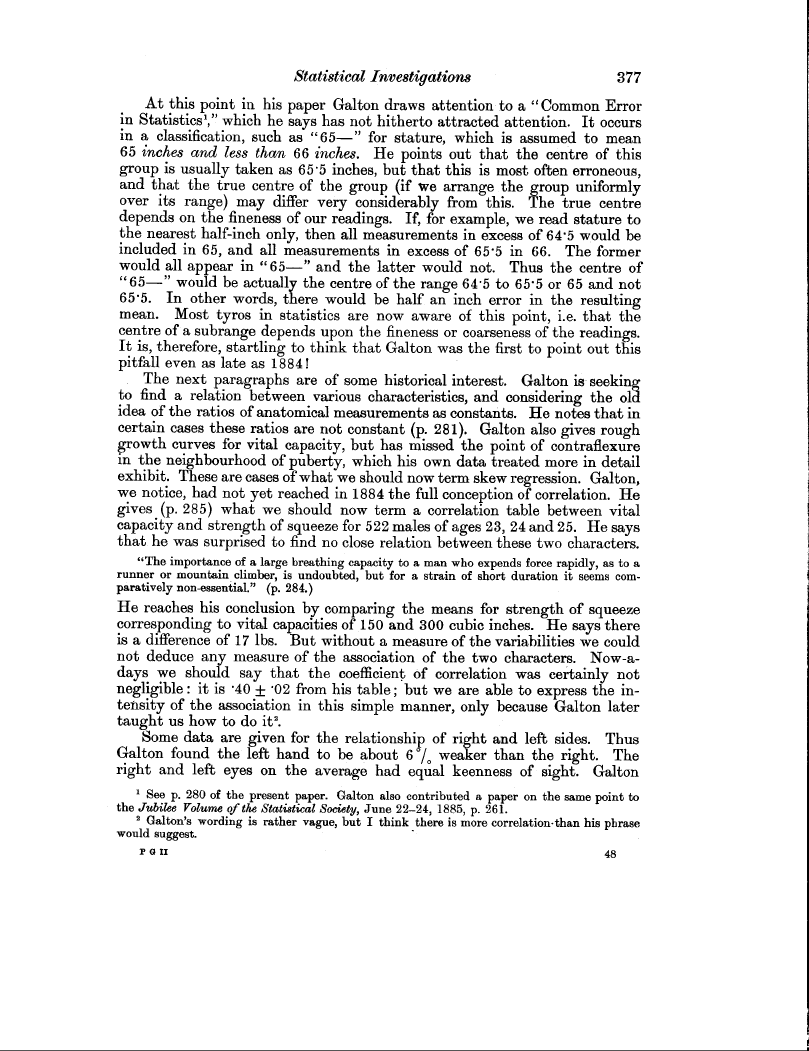Statistical Investigations 377
At this point in his paper Galton draws attention to a "Common Error in Statistics'," which he says has not hitherto attracted attention. It occurs in a classification, such as "65-" for stature, which is assumed to mean 65 inches and less than 66 inches. He points out that the centre of this group is usually taken as 65.5 inches, but that this is most often erroneous, and that the true centre of the group (if we arrange the group uniformly over its range) may differ very considerably from this. The true centre depends on the fineness of our readings. If, for example, we read stature to the nearest half-inch only, then all measurements in excess of 64.5 would be included in 65, and all measurements in excess of 65.5 in 66. The former would all appear in "65-" and the latter would not. Thus the centre of "65-" would be actually the centre of the range 64.5 to 65.5 or 65 and not 65.5. In other words, there would be half an inch error in the resulting mean. Most tyros in statistics are now aware of this point, i.e. that the centre of a subrange depends upon the fineness or coarseness of the readings. It is, therefore, startling to think that Galton was the first to point out this pitfall even as late as 1884
The next paragraphs are of some historical interest. Galton is seeking to find a relation between various characteristics, and considering the old idea of the ratios of anatomical measurements as constants. He notes that in certain cases these ratios are not constant (p. 281). Galton also gives rough growth curves for vital capacity, but has missed the point of contraflexure in the neighbourhood of puberty, which his own data treated more in detail exhibit. These are cases of what we should now term skew regression. Galton, we notice, had not yet reached in 1884 the full conception of correlation. He gives (p. 285) what we should now term a correlation table between vital capacity and strength of squeeze for 522 males of ages 23, 24 and 25. He says that he was surprised to find no close relation between these two characters.
"The importance of a large breathing capacity to a man who expends force rapidly, as to a runner or mountain. climber, is undoubted, but for a strain of short duration it seems comparatively non-essenial." (p. 284.)
He reaches his conclusion by comparing the means for strength of squeeze corresponding to vital capacities of 150 and 300 cubic inches. He says there is a difference of 17 lbs. But without a measure of the variabilities we could not deduce any measure of the association of the two characters. Now-adays we should say that the coefficient of correlation was certainly not negligible : it is •40 ± -02 from his table ; but we are able to express the intensity of the association in this simple manner, only because Galton later taught us how to do it'.
Some data are given for the relationship of right and left sides. Thus Galton found the left hand to be about 6'/. weaker than the right. The right and left eyes on the average had equal keenness of sight. Galton
' See p. 280 of the present paper. Galton also contributed a paper on the same point to the Jubilee Volume of the Statistical Society, June 22-24, 1885, p. 261.
2 Galton's wording is rather vague, but I think there is more correlation-than his phrase would suggest.
ron 48

